Gatun Lock

At 9:50 we arrive at the "Gatun" lock.
The "Gatun" lock has a set of 2 parallel groups of 3 locks
each.
Each set of locks covers a difference in altitude from the
Lake to the Atlantic Ocean of 85 feet or 26 meters.
Each lock is 33,5 m wide and 305 m long.
Maximum dimensions of ships allowed through the channel are:
Length: 294,13 meters (965 feet)
Beam: 32, 31 meters (106 feet)
Draft: 12,04 meters (39,5 feet)
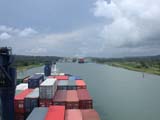

The "Cherokee Bridge" is being manoeuvred into the first
lock by some tugs.
The "MSC Matilde" already is moving into the second lock.
In front of the "MSC Matilde" already in the third lock a
green tanker can be seen.

On board of the "Matisse" all doors on all decks and the
gates between floor B and floor A are closed and locked.
This precaution needs to be taken to prevent theft as a local
group of aprox. 18 people will be boarding soon and staying
on board over the whole journey.
The task of these people is to tighten and release the steal
ropes from the trains onto the ship.
This explains the 18 people:
- 3 locomotives on each side with two ropes each (= 12 ropes
= 12 people)
- one supervisors for the bow and the stern on each side
(= 4 people)
- 2 pilots
All are wearing neat uniforms and safety helmets.

The pilot passes instruction to the captain regarding the
speed and the direction of the motion of the "Matisse".



Our tugs arrive and take up their positions.
The "Matisse" is now moving so slow that it is not manoeuvrable
anymore.
The tugs start pushing the "Matisse" towards the miter gates.
Shortly before the locks the "Matisse" will be stopped and
pressed against the pier.
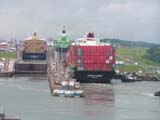
The tugs have finished their job with the "Cherokee Bridge".
She is now safely attached to the little trains and moving
into the lock.
It is now our turn to move closer.

The arrow at the pier indicates on which side the "Matisse"
is supposed to use the lock.


At 9:50 we arrive at the first gate lock.
On each side of the "Matisse" 3 electrical rack railway locomotives
are waiting.
These locomotives are not really used for towing but to keep
the ships in position while going through the locks.
The forward speed is provided with the ship's engine and
propeller.

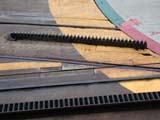
At the end of the pier a turntable is available so the locomotives
can be moved from one to the other side depending on the
place where they are required.
After being turned the locomotives need to be lifted into
the rack again with a gear mechanism.

The steel cables required for keeping the ship in his position
are attached and tightened by the local group on board of
the "Matisse".
They are attached to the ship at the entry of the first lock
and released at the end of the last lock.
The commands are given by the locomotive driver with lights
and also whistle blows.
The local group members on board of the ships reply by also
blowing with whistles.


For Roger and Ruedi it is the first time that they pass
the Panama Channel.
They are very busy watching and discussing all.

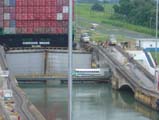

The "Cherokee Bridge" has entered the lock and the gate
is closed.
The swivel bridge is turned into position and the traffic
allowed to get to the other side of the lock again.


At 10:14 the captain orders the machines of the "Matisse"
to be set to "slow forward".
The "Matisse" starts moving into the lock with aprox. 4 kmh.
To ensure that the ship stays in the middle of the lock that
the locomotive and the ship must move in the same speed.

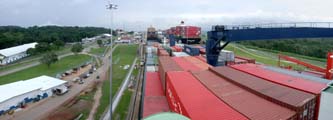
The "Matisse" has 12 containers across and is 30, 6 m wide.
The distance between the walls of the lock and the "Matisse"
are aprox. 0,5 m on one side and aprox. 2,5 m on the other
side
(lock widths of 33,5 m minus beam of "Matisse of 30,6 m =
2, 9 m).
The ships in front of the "Matisse" both have 13 containers
across, 1 container more than the "Matisse".
This leaves very little space on both sides.
In one case we were able to watch and listen to the "MSC
Matilde" being more dragged then sailed out of a lock.
Smoke was coming up between the lock walls and the ships
side walls and loud screeching could be heard.
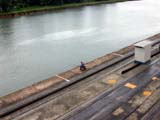
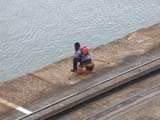

On the other side of the pier somebody is waiting for the
"Cap Ortegal" ....

At 10:16 the pilot and captain command "machine stop". The "Matisse" continues
to glide into the lock unaided.
Shortly after the command is "forward slowly" and at 10:25
the "Matisse" has reached the desired position. The captain
commands "machine stop".
The speed of the ship entering into the lock is felt as rather
fast as the ship needs to be stopped at a precise spot so
it does not run into the next gate lock.
As the "Matisse" is the second last ship to be moved upwards
through the locks this morning the two tugs
"Trinidad" and "Grula" previously used to push the "Matisse" follow
into the lock.
They will be required later on on the lake to assist the
ships going downwards.
The miter gate start closing slowly.



To overcome the difference in height at the miter gates
slopes need to be overcome by the locomotives during the
process of changing form one lock to the next one.
As one locomotive climbs the slope the other ones hold the
ship in position.
The last locomotive stabilising at the stern of the ship
only climbs the slope after the ship has moved through the
miter gate.
Click here  to view the movie. to view the movie.

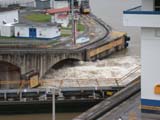
The "Cherokee Bridge" has moved on to the next lock and
the miter gate has been closed behind her.
The water is released from the neighbouring lock to be ready
for the next ship.
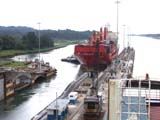

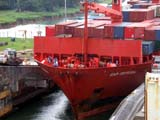
The "Cap Ortegal" is the next ship being guided into the
lock by the locomotives.
The local group of people are all present in the bow doing
their job ...
The "Cap Ortegal" is the last ship going up this morning.
Their tugs also follow into the locks as they will required
at the end of the lock system to push the ships going downwards
into the locks.


At 10:37 the miter gates are closed and the water starts
entering the lock.
Slowly the "Matisse" starts rising in the lock.
The water to fill the locks is taken from the "Lago de
Gatun" that is used as watershed.
The lake is fed with fresh water by the surrounding rivers.
Aprox. 197 million liters of water are used for each lockage.
When the channel was built it was decided not to use saltwater
to operate the lock because of the corrugation of the equipment.
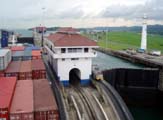


Once the lock chamber is full the gate to the next lock
is opened and at 10:48 the "Matisse" slowly propels itself
into the 2nd lock.
Again the tugs follow.
Each set of locks features a Control House on the centre
wall of its higher chamber, from which the entire operation
is directed.

We can again watch the locomotives overcome the slope.
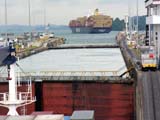

At 11:01 the miter gate closes.
As the water starts rising lifting the "Matisse"
the "MSC Matilde" has already completed this side of the
locks and is moving onwards into the"Lago de Gatun".

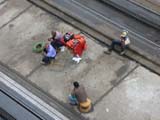
The "Cap Ortegal" is rising in the first lock and the workers
patiently wait for their time to come to perform their duty.

We have time to have a look at the pilots equipment.
They come fully equipped with their own GPS, and PC and software
and are connected to the control tower via V-LAN.


At 11:14 the miter gates open to the third lock and the "Matisse"
is moved over.
After the closure of the miter gates at 11:29 the lock is
filled and at 11:40 we are ready to leave the last lock.
The "Matisse" is directed out of lock and picks up speed
immediately.
One after the other the steel cables are released at the
ship and pulled up by the locomotives.
Better not think about what would happen if one of those
cables is not released on time ...
The locomotives are then parked at the end of the pier.
The third lock has double doors towards the lake as it needs
to support the pressure of the lake.
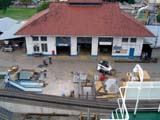


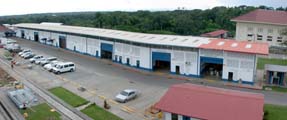

Construction work and maintenance are ongoing at the whole
Panama Channel.
Large facilities can be found along the locks.
back to top
|
![]() Created by Level X Webdesign
Created by Level X Webdesign